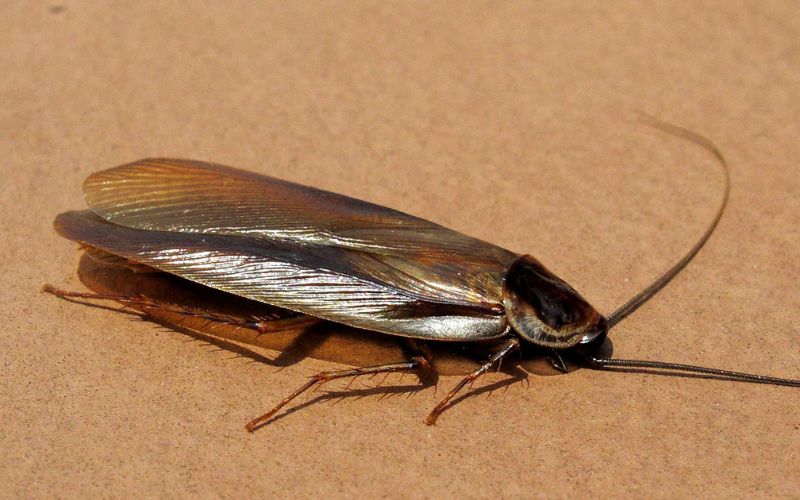Flying cockroaches are a homeowner’s nightmare. Unlike their crawling counterparts, these pests can invade the upper spaces of your home, making them more difficult to eliminate. Understanding their behavior, identifying the type of cockroach, and employing effective eradication strategies are crucial steps in tackling this problem. This article will delve into everything you need to know about getting rid of flying cockroaches, from prevention to treatment.
Understanding Flying Cockroaches
Flying cockroaches are not a separate species; they are simply cockroaches that have developed wings and the ability to fly. Common species that can fly include the American cockroach, the Australian cockroach, and the Smokybrown cockroach.
Key Characteristics
- American Cockroach (Periplaneta americana): Known for its large size, reddish-brown color, and the yellowish figure-eight pattern on the back of the head. They can grow up to 3 inches and are strong fliers.
- Australian Cockroach (Periplaneta australasiae): Similar in appearance to the American cockroach but slightly smaller, with yellow markings on the thorax and wings. They are also proficient fliers.
- Smokybrown Cockroach (Periplaneta fuliginosa): Dark brown to black, these cockroaches are fully winged and capable of sustained flight.
Why Do Cockroaches Fly?
Cockroaches typically use their wings to glide or to escape predators. The conditions that might cause a cockroach to fly include:
- Warm Temperatures: Cockroaches are more likely to fly in warmer climates or during the summer months.
- Light Sources: Some species are attracted to light and may fly towards it.
- Escape Mechanism: Flight is often a defense mechanism to escape danger quickly.
Prevention Methods
The best way to deal with flying cockroaches is to prevent an infestation from occurring in the first place. Here are some effective prevention strategies:
Maintain Cleanliness
- Regular Cleaning: Keep your home clean by regularly sweeping, mopping, and vacuuming. Pay special attention to the kitchen and dining areas where food particles are more likely to accumulate.
- Food Storage: Store food in airtight containers and avoid leaving food out overnight. Clean up spills immediately and keep countertops and tables free of crumbs.
- Garbage Management: Dispose of garbage regularly and use trash cans with tightly fitting lids. Clean your garbage bins periodically to prevent odor build-up.
Eliminate Water Sources
Cockroaches need water to survive. Reducing their access to water sources can significantly deter them from inhabiting your home.
- Fix Leaks: Repair any leaky faucets, pipes, or appliances. Even small drips can provide enough moisture for cockroaches.
- Dehumidify: Use a dehumidifier in damp areas like basements and bathrooms to reduce moisture levels.
- Pet Water: Avoid leaving pet water dishes out overnight and ensure they are emptied and cleaned daily.
Seal Entry Points
Cockroaches can enter your home through small cracks and gaps. Sealing these entry points can help prevent an infestation.
- Cracks and Crevices: Inspect your home for any cracks in walls, floors, and foundations. Seal them with caulk or other appropriate materials.
- Doors and Windows: Install weather stripping on doors and windows and repair any damaged screens.
- Utility Openings: Seal gaps around pipes, electrical wires, and vents that lead into your home.
Identification and Inspection
Proper identification of the type of cockroach and the extent of the infestation is crucial for effective treatment.
Signs of Infestation
- Droppings: Cockroach droppings resemble black pepper or coffee grounds and are usually found in areas where they are active.
- Egg Casings: Look for oval-shaped egg casings (oothecae) in hidden areas such as behind appliances, in cabinets, and under sinks.
- Shed Skins: Cockroaches shed their skins several times as they mature. These skins can be found near their hiding places.
- Unpleasant Odor: A strong, musty odor can indicate a large infestation.
Inspection Techniques
- Night Inspection: Since cockroaches are nocturnal, inspect your home at night with a flashlight to spot them.
- Sticky Traps: Place sticky traps in suspected areas to monitor cockroach activity and identify species.
- Professional Inspection: Consider hiring a pest control professional for a thorough inspection and accurate identification.
Treatment Methods
Once an infestation is confirmed, it’s time to take action. There are several methods to eliminate flying cockroaches, ranging from DIY approaches to professional extermination.
DIY Methods
- Baits: Use gel baits or bait stations that contain slow-acting insecticides. Cockroaches will consume the bait and carry it back to their nests, effectively killing others in the colony.
- Insecticidal Sprays: Use aerosol insecticides labeled for cockroach control. Apply them directly to cockroaches or in areas where they are likely to hide.
- Dust Insecticides: Apply insecticidal dust like boric acid or diatomaceous earth in cracks, crevices, and other hiding spots. These dusts are ingested by cockroaches and lead to dehydration and death.
- Homemade Remedies: Solutions like a mixture of baking soda and sugar can be effective. The sugar attracts cockroaches, and the baking soda disrupts their digestive system, leading to death.
Professional Extermination
For severe infestations, professional pest control services are often necessary.
- Integrated Pest Management (IPM): Professionals use a combination of methods, including chemical and non-chemical treatments, to effectively manage and eliminate cockroach infestations.
- Heat Treatments: Pest control experts can use heat treatments to kill cockroaches and their eggs without the use of chemicals.
- Fumigation: In extreme cases, fumigation may be required. This involves sealing your home and filling it with a fumigant gas that penetrates all areas, killing cockroaches.
Long-Term Maintenance
Eliminating flying cockroaches is not a one-time effort. Ongoing maintenance and monitoring are essential to prevent re-infestation.
Regular Inspections
- Monthly Checks: Conduct regular inspections of your home, especially in high-risk areas like kitchens and bathrooms.
- Professional Monitoring: Some pest control companies offer ongoing monitoring services to ensure your home remains cockroach-free.
Continued Sanitation
- Cleaning Routine: Maintain a consistent cleaning routine to keep your home free of food particles and debris.
- Proper Storage: Continue to store food in sealed containers and manage garbage effectively.
Repair and Sealing
- Home Maintenance: Regularly inspect and repair any new cracks, leaks, or gaps that could serve as entry points for cockroaches.
- Weather Stripping: Replace worn-out weather stripping on doors and windows.
Environmental Control
Managing the environment around your home can also help reduce the likelihood of a cockroach infestation.
Outdoor Cleanliness
- Yard Maintenance: Keep your yard clean by removing leaf litter, woodpiles, and other debris where cockroaches can hide.
- Proper Drainage: Ensure proper drainage around your home to prevent standing water, which can attract cockroaches.
Landscaping Tips
- Trim Vegetation: Trim shrubs and trees away from your home’s exterior to reduce hiding spots for cockroaches.
- Mulch Management: Avoid placing mulch directly against the foundation of your home, as it can provide shelter for cockroaches.
Conclusion
Getting rid of flying cockroaches requires a combination of prevention, identification, treatment, and ongoing maintenance. By understanding their behavior, implementing effective prevention strategies, and employing appropriate treatment methods, you can successfully eliminate these pests from your home. Remember that persistence and vigilance are key to maintaining a cockroach-free environment. If an infestation becomes overwhelming, do not hesitate to seek professional pest control services to ensure your home remains safe and comfortable.





